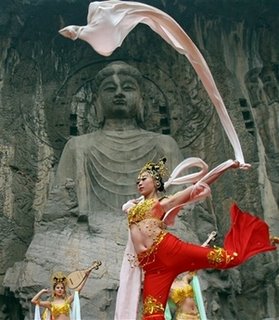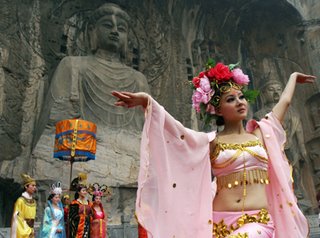Empress Wu Zetian


Actors perform during an Empress Wu Buddha-worship ceremony held at Longmen Grottoes, in Luoyang, central China's Henan Province, Monday, Oct. 16, 2006. The ceremony is an imitation of the Buddha-worship ritual of Empress Wu Zetian, the only empress in Chinese history, according to records of the murals and statues of Longmen Grottoes. Empress Wu, the only reigning female in the History of China, created several unique Chinese characters to demonstrate her power. The characters were not created by the Empress herself, they were suggested by an official named Zōng Qínkè (宗秦客) in December 689 A.D. The number of these characters is controversial, but various sources say 12 to 19 characters. They were forcibly used by people during her reign but fell into disuse immediately after her death, so they help to determine dates of printed materials.
A few of the surviving characters are preserved in the written histories of Wu Zetian, and a few have found themselves incorporated into modern-day computer standards, classified as either variant or dialect-specific characters.
The form of the characters varies depending on where they are printed. For instance Empress Wu's own name zhào 照 was replaced with 瞾, but is erroneously thought to be 曌, and looking in the Kangxi Dictionary, one finds the description of the former having two 目 ("eye") characters being the proper character rather than the word míng 明 meaning "bright". Another form replaces the 明 above 空 with two 日 characters.
In Japanese, they are known as Sokuten Moji (則天文字).




0 Comments:
Post a Comment
<< Home